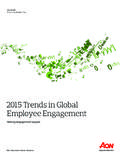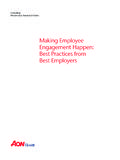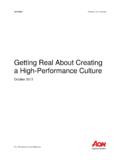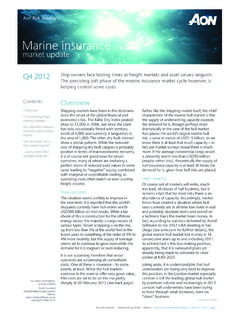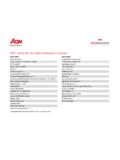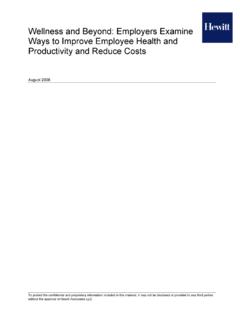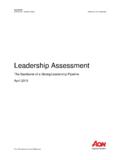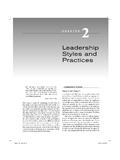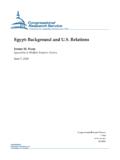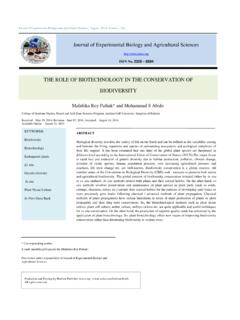Transcription of The Impact of Behavioral Economics on Retirement Plans
1 Behavioral Changes Behavioral changes The Impact of Behavioral Economics on Retirement Plans Throughout the Retirement process, individuals are in a continuous state of making decisions. From deciding when to start deferring money to a 401(k) plan , to figuring out how Retirement money should be invested and when to rebalance, to choosing which date to commence Social Security benefits, we are always making choices. Wherever there is choice, Behavioral Economics plays a role. This article introduces concepts of behav . ioral Economics and discusses their Impact on Retirement Plans . It draws on research from noted Behavioral economists to showcase not only what irrational Retirement decisions we make, but also how employers are combating them through automation features, premixed portfolios and the like. Finally, it concludes with how Behavioral Economics principles can be applied to create future 401(k) features.
2 By Rob Austin | Aon Hewitt I. magine for a moment that you're a fly on a wall observ- 1. Use it to buy something nice for someone special. ing a social science experiment. An individual saunters 2. Invest it in a Retirement account. past you and puts on a digital headset resembling some- 3. plan a fun and extravagant occasion. thing akin to 3-D movie glasses, but it covers the entire top 4. Put it into a checking account. of the head and is tethered to a computer through a long um- Half of the participants allocated more to the Retirement bilical cord in the back. accounts than the other half. Much more. Like double the Can you see yourself in the mirror in front of you? asks amount. Why did this group devote more of their funds to the researcher. If so, please turn around 180 degrees. Retirement ? The answer lies in what they saw in their headsets.
3 Some participants are more graceful than others in their Hal Hershfield, a social scientist at New York University, pirouetting, but all face the back of the room and then turn and six of his colleagues (Hershfield et al., 2001) hypothe- around again to receive a few simpler instructions: Nod in sized that part of the Retirement savings crisis in this country front of the mirror, Tilt your head to the side and so forth. stems from the fact that individuals have a hard time visual- These instructional dance calls last for a minute. izing themselves in Retirement . Our brains are conditioned As the headsets come off, participants are asked to imag- to place a greater weight on near-term gratification at the ine that they just unexpectedly received $1,000 and were expense of long-term gain. To combat this, Hershfield de- asked to allocate it to among four options: cided to harness the power of technology to help partici- third quarter 2013 benefits quarterly 25.
4 Behavioral changes pants see what they might look like as This research is part of an emerg- paperwork and start receiving checks a retiree. In the headset of the group ing and growing field called Behavioral throughout their golden years. The that saved more to Retirement was a Economics a discipline that is located simplicity of the process makes it so computer-generated digital represen- at the intersection of neoclassical eco- there is not much room for people to tation of themselves as a 70-year-old. nomics and psychology. Studies in this make irrational decisions. The other half of the participants saw area generally answer at least one of Contrast that with the choices and merely an avatar of themselves at their two questions: (1) Why do people make decisions a defined contribution par- current ages, and they acted as the con- suboptimal choices?
5 And/or (2) what ticipant faces: When should I start sav- trol group. conditions can be changed to improve ing? How much should I save? Should Hershfield and his researchers took the the outcome? I put this into a pretax account or a experiment further and determined that it Why this field of study is important Roth account? Into which fund or funds was necessary for participants to see what to Retirement Plans is clear. Simply put, should I invest? When should I rebal- they may look like at the age of 70 and not as defined benefit pension Plans have ance? When do I change my future allo- just some random septuagenarian. For re- faded away and been replaced by de- cations? Is this fund worth the fees it is tirement savings to increase, there needs fined contribution Plans , participants charging? Should I roll a balance from a prior employer into this plan ?
6 These are all questions the individual must con- Retiring from the workforce begs the defined contribution template before even deciding to retire. Retiring from the workforce begs participant to answer even more questions. Should I the defined contribution participant to answer even more questions. Should reallocate my portfolio to mitigate risk? How much should I reallocate my portfolio to mitigate risk? How much should I take out each I take out each month? Will the money last until I die? month? Will the money last until I die? Should I keep the money in the plan Should I keep the money in the plan or roll it over? Should or roll it over? Should I purchase some longevity insurance? The list goes on. I purchase some longevity insurance? The list goes on. So, whenever there are questions, Behavioral Economics seeks answers. This article is going to explain some to be that connection between the current are asked to make exponentially more traits of Behavioral Economics .
7 It's self and the future self. Fortunately for decisions. In most defined benefit pen- structured to showcase some research those of us without expensive immersive sion Plans , participants never need to and then describe its applicability to virtual reality environments, the research make a choice until it comes to retire- the Retirement space. Finally, it con- team also showed that it was enough just ment. Once they decide to retire, par- cludes with how Behavioral Economics to use a little software modeling to add ticipants generally are asked to make could be designed to create the defined some wrinkles and a touch of gray hair one decision: In what form do you wish contribution plan of tomorrow. for participants to have a pretty good idea to receive your benefit? They usually of what they'll look like as a retiree. Once are provided with explanations of the Trait One: Anchoring participants had this image, they tended to flavor of annuities and are shown a cor- To understand the concept of an- save more toward Retirement than those responding set of numbers.
8 They check choring, be a willing participant in this who didn't see their future self. a box, add a few signatures, return their short, two-step experiment: (1) Say the 26 benefits quarterly third quarter 2013. Behavioral changes word silk five times as quickly as possible. Silk. Silk. Silk. Some variability between countries is to be expected, but Silk. Silk. (2) What does a cow drink? a gulf between the groups of this magnitude should clue you Chances are you thought that the answer was milk. Cows in that something else is going on. The first group of coun- drink water. It's an understandable error. After saying ilk so tries requires individuals to opt in to being an organ donor. often in silk, you have primed your brain to think of other Only those who actively take action are included. The coun- words that sound like it. So when you hear cow and drink, it tries in the second group are structured conversely.
9 Resi- is not a leap to the word milk. You were already anchored dents of these countries are required to opt out of being an on ilk words. organ donor. What Johnson and Goldstein's research helps For a far more robust study on anchoring, consider the illustrate is the power inertia has in anchoring our decision research done by Dan Ariely, a Behavioral economist and making. the best-selling author of Predictably Irrational, where he Retirement plan sponsors have taken a page from Johnson asked research participants to take part in an auction (Ar- and Goldstein's research by implementing automatic enroll- iely et al., 2003). Of course, since this was a research ex- ment in their Plans . By some accounts (Aon Hewitt, 2012), periment, it was no ordinary auction. Before it started, the 55% of companies enter newly hired employees into their participants were asked to write down the last two digits of defined contribution plan unless they opt out.
10 The gap be- their Social Security number. While the first few digits of tween the participation rates of companies that automatically Social Security numbers are based on geography, it is fairly enroll versus those that require active enrollment is not as big safe to say that the last two digits are about as random as any as what Johnson and Goldstein found for organ donor par- numbers could be. ticipation in countries, but it is still noteworthy. According to Participants were then asked to participate in the auction. some studies ( , Aon Hewitt, 2011), the average participa- The averages of the results are shown in the table. tion rate for employees who were subject to automatic enroll- Two things should jump out at you. First, people who had ment is 85%. This is fully 18 percentage points higher than higher last digits of their Social Security numbers were will- the participation rate for employees who were not subject to ing to pay more than those with lower numbers.
